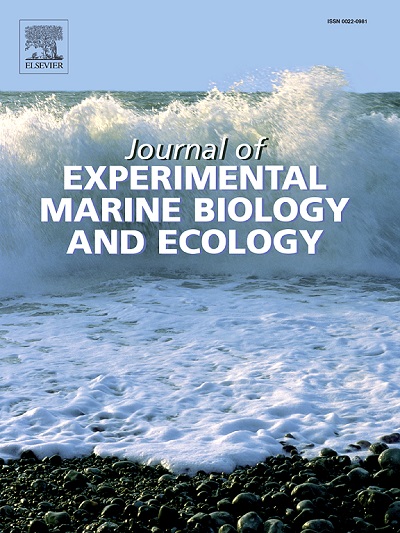Combined effects of pCO2 and salinity on the silicification of estuarine diatoms
IF 1.8
3区 生物学
Q3 ECOLOGY
Journal of Experimental Marine Biology and Ecology
Pub Date : 2025-01-01
DOI:10.1016/j.jembe.2024.152078
引用次数: 0
Abstract
Understanding the combined effects of seawater acidification and salinity is crucial for assessing the adaptation of estuarine organisms to climate change. This study examined the physiological and nanostructural responses of two coastal diatoms, Thalassiosira pseudonana and Thalassiosira weissflogii, under different pCO2 and salinity conditions. Our results indicated that high pCO2 and low salinity decreased the biogenic silica and chlorophyll contents in both species. The weakly condensed silicon increased alongside the decrease in biogenic silica under high pCO2 conditions, with this trend being further amplified in low salinity environments. Meanwhile, the biochemical compositions and nanostructure of the diatom frustules were significantly altered by the lower salinity, leading to reduced cell size and porosity. These changes to diatom physiology and morphology may affect the diatoms' capacity to defend against predators and viruses. This study highlights the chemical and morphological changes occurring in diatom cell walls in future acidic estuarine waters.
pCO2和盐度对河口硅藻硅化的联合影响
了解海水酸化和盐度的综合影响对于评估河口生物对气候变化的适应至关重要。本文研究了两种滨海硅藻——假海藻(thalassisira pseudonana)和魏氏藻(thalassisira weissflogii)在不同二氧化碳分压和盐度条件下的生理和纳米结构响应。结果表明,高pCO2和低盐度降低了两种植物的生物源二氧化硅和叶绿素含量。在高pCO2条件下,弱凝聚硅随着生物源硅的减少而增加,在低盐度环境下,这一趋势进一步放大。同时,低盐度显著改变了硅藻胞体的生化组成和纳米结构,导致胞体尺寸和孔隙度减小。这些硅藻生理和形态的变化可能会影响硅藻抵御捕食者和病毒的能力。本研究强调了未来酸性河口水域中硅藻细胞壁的化学和形态学变化。
本文章由计算机程序翻译,如有差异,请以英文原文为准。
求助全文
约1分钟内获得全文
求助全文
来源期刊
CiteScore
4.30
自引率
0.00%
发文量
98
审稿时长
14 weeks
期刊介绍:
The Journal of Experimental Marine Biology and Ecology provides a forum for experimental ecological research on marine organisms in relation to their environment. Topic areas include studies that focus on biochemistry, physiology, behavior, genetics, and ecological theory. The main emphasis of the Journal lies in hypothesis driven experimental work, both from the laboratory and the field. Natural experiments or descriptive studies that elucidate fundamental ecological processes are welcome. Submissions should have a broad ecological framework beyond the specific study organism or geographic region.
Short communications that highlight emerging issues and exciting discoveries within five printed pages will receive a rapid turnaround. Papers describing important new analytical, computational, experimental and theoretical techniques and methods are encouraged and will be highlighted as Methodological Advances. We welcome proposals for Review Papers synthesizing a specific field within marine ecology. Finally, the journal aims to publish Special Issues at regular intervals synthesizing a particular field of marine science. All printed papers undergo a peer review process before being accepted and will receive a first decision within three months.

 求助内容:
求助内容: 应助结果提醒方式:
应助结果提醒方式:


